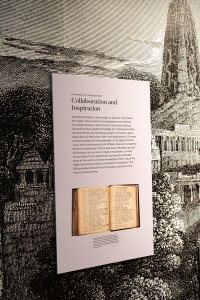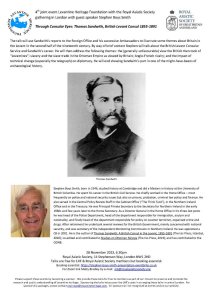Bayly Prize 2023 Shortlist Announced
The Society is delighted to announce the shortlist for the 2023 Bayly Prize for a distinguished thesis on an Asian subject from a British or Irish University. The prize was established to honour the work of Professor Sir Christopher Bayly (1945-2015). We would like to thank the judges for their careful consideration of each submission: Professor Benjamin Hopkins (George Washington University), Professor Susanne Brandtstädter (Koln), Professor Magnus Marsden (Sussex), Dr Rian Thum (Manchester), and Professor Nile Green (UCLA).
Shortlist:
- Dr. Thomas Barrett (University of Oxford), ‘Foreigners and the Making of the Chinese Diplomat’
- Dr. Kelsey Granger (University of Cambridge), ‘Gifts from afar: The Creation of an Imperial Lapdog in Tang-Song China’
- Dr. Mariano Errichiello (School of Oriental and African Studies), ‘IIme Ksnum: an Esoteric Interpretation of Zoroastrianism, History and Beliefs’
- Dr Yui Chim Lo (University of Oxford), ‘Imagining the Continent’s Future: China, India and Post-War Asia, 1937-1949’
We would like to extend our congratulations to all the shortlisted candidates and look forward to announcing the winner in due course.
————————————————————————————
In other news, our Extraordinary Endeavours Exhibition at the Brunei Gallery, SOAS, continues to attract many visitors. Do take the opportunity to visit or re-visit before the exhibition closes on 15th December. In this week’s blog Dr. Amy Matthewson writes about some more of our displayed collections:
The Laws and Procedures of the Great Qīng Dynasty and the Latin-Chinese Dictionary
The Royal Asiatic Society’s exhibition Extraordinary Endeavours at the Brunei Gallery in London focusses on the long history of communication, collaboration, and dissemination from the founding of the Society to the present day. The collections contain a wealth of books, manuscripts, artworks, and photographs that could easily have been displayed thereby making the selection process challenging.
Two books that were chosen for display provide interesting examples of such representations of communication and collaboration. One, to be found in a case, is a book titled, Ta Tsing Leu Lee (transliterated today as Dà Qīng Lǚlì 大清律例, The Laws and Procedures of the Great Qīng Dynasty), translated by George Staunton in 1810. He translated a significant part of the Qing Penal Code and this was the first direct English translation of a Chinese text.

The other’s image is found on the wall next to the case, just before heading down to the lower gallery. This is a Latin-Chinese dictionary that was compiled in 1745 and acquired by the Augustinian missionary Padre Adeodato in Peking (Beijing). What makes this particular dictionary unusual is that it is Latin-Chinese, rather than Chinese-Latin. This dictionary was painstakingly conserved a few years ago and you can read about the process in this blogpost.
These books came into being because of a combination of historical occurrences: the significance of cross-cultural contacts, such as the Jesuits in China that began in the sixteenth century, and the expansion of global trade during the eighteenth century. They are fascinating objects in what they reveal but also in what they conceal.

They invite us to think globally and consider not only the language and cultural skills required that enabled the production of these books but also the desire for knowledge acquisition and dissemination. But behind the pages, the books hide the dangers translators face when political conditions are not favourable (as demonstrated in Henrietta Harrison’s The Perils of Interpreting) as well as the complicated process of getting meaning across when translating sensitive materials (how does one, for example, take a word heavy with cultural connotation and transmit it to an audience whose frameworks are very different?).
But translated these books were, and they formed an important part in shaping ideas of and about China.
On Tuesday 28 November, 6.30 p.m., we will hold the 4th joint event with the Levantine Heritage Foundation at the Royal Asiatic Society, when Stephen Boys Smith will lecture on ‘Through Consular Eyes: Thomas Sandwith, British Levant Consul 1855-1891’ using Sandwith’s reports to the Foreign Office and his successive Ambassadors to examine British involvement in the Levant in the second half of the nineteenth century. All are welcome to attend but booking is essential via eventbrite. If you wish to attend via zoom please contact Matty Bradley.

And on Friday 1 December, 7pm, this time at the Djam Lecture Theatre, SOAS Main Building, (10 Thornhaugh Street, London, WC1H 0XG) the Royal Asiatic Society join with the Society for Anglo-Chinese Understanding and the SOAS Chinese Culture Society for the Meridian Society’s event when Jessica Harrison-Hall the British Museum’s Head of China Section and the China’s Hidden Century exhibition’s lead curator, will give a retrospective view of the exhibition. After her talk she will be joined by Dr Lars Laamann, Senior Lecturer in the History of China at SOAS, and Dr Hwee-San Tan, Research Associate in Ethnomusicology at SOAS, for a panel discussion on this period of history. There will also be by performances of Qing court music by the SOAS Sizhu Ensemble. The event is free, but donations are welcome and all proceeds will go to the SOAS Sizhu Ensemble to fund their trip to Portugal next year. Please RSVP to themeridiansociety@gmail.com if you are planning to attend.

